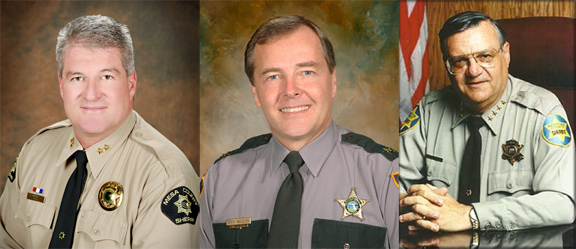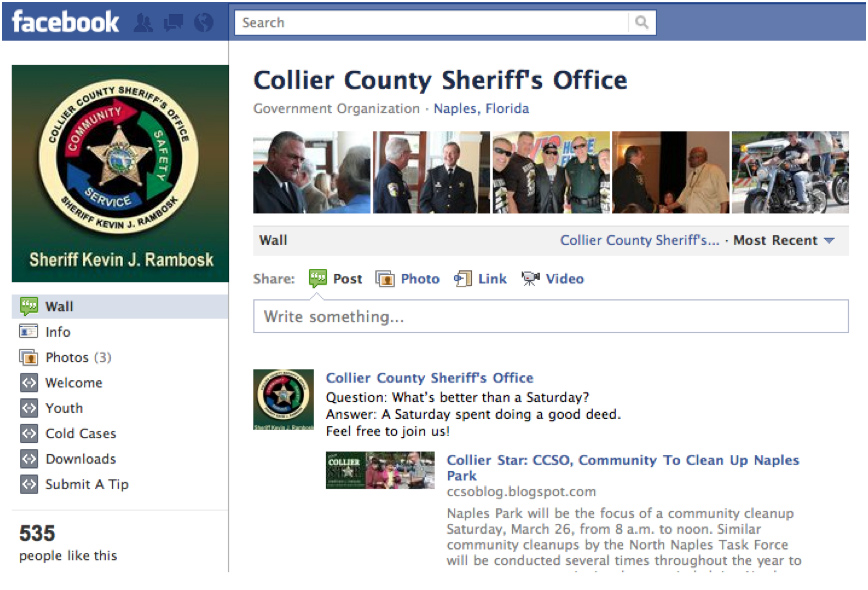“I don’t actually do the twitting; I’m a carona kinda guy”. Maricopa County Sheriff Joe Arpaio wasn’t talking about cigars, or beer, for that matter. He was referring instead to his Smith Carona typewriter, when interviewed for this article on the risk and benefits of his sheriff department’s use of social media. But then he clarified, “I do tweet them myself, I just don’t use the machine. I say ‘I am going to San Francisco tomorrow’ and my Captain puts it into the machine.”
Whether he dictates his tweets, or the Captain liberates a few without him is immaterial at some level. As a recent Maricopa CSO news release pointed out, he’s got a combination of 110,000 connections if his Facebook fans and Twitter followers are put together. A statistic that surprised Sheriff Joe so much he dictated a tweet about it, leaving at least this writer to wonder if he dictated instructions to include the link to the press release too:
Both the Twitter and Facebook profiles are in the Sheriff’s name. The Maricopa CSO has no agency presence in social media yet. The PIO office has plans to expand as an agency as well, but for right now they see social media as a way to personalize their boss; widely recognized as one of the most colorful, as well as controversial, top cops around. Maricopa CSO PIO Lisa Allen explained, “everybody knows him as the toughest sheriff in America and a great law enforcement guy. What not everyone knows though is that he’s a really great guy and a regular guy. So it’s our mission to humanize him a little bit more.”
The “toughest Sheriff in America” readily admits he doesn’t understand the precise ins and outs of the technology that we’ve come to refer to as social media. But, as with many law enforcement executives who don’t necessarily push the buttons themselves, he has developed a keen understanding of a key benefit to using social media. He summed it up this way, “We arrested ten people yesterday for drug trafficking and illegal immigration. The media won’t cover that because it makes us look good.” But Sheriff Joe and his team used every avenue at their disposal to make sure word of the arrests reached his followers through social media channels.
Getting stories out that the traditional media won’t cover, or having the means to balance the scales when they do cover them but get them wrong, is one of the first benefits most law enforcement leaders realize when beginning a social media program. For many, it has become that “ah-hah” moment when it occurs to them that the benefits to using social networking tools far outweigh any risks they may fear.
The Learning Curve
Mesa County (Colorado) Sheriff Stan Hilkey was vacationing in Hawaii when the earthquake and tsunami disasters hit Japan. The local media learned of his whereabouts from his online posts and soon had him reporting in from his location. And, when one local media outlet prematurely reported the names of two homicide victims, Sheriff Hilkey was still in Hawaii but used Facebook to let them know how disappointed he was.
As many agencies learn, there’s no one-size-fits-all way of doing things in the digital world, and it is no different for the Mesa CSO. PIO Heather Benjamin said they’ve gone through a bit of a learning curve with social media, “We had a blog that was really spread out, it’s more focused now. We’ve really tied our profiles altogether, they each have their own functions.”
Part of the learning curve for Mesa has also been realizing that many of the things they worried about, haven’t become the big problems they thought they would be. They had to overcome some initial resistance from command staff but even they have come to appreciate the upside. She explained, “When we have a negative media story that we didn’t agree with, that used to really frustrate them. Now we have this outlet to clarify.” In the beginning they also worried about loss of productivity. “We thought people would get on Facebook all day and wouldn’t do their jobs. That just hasn’t been reality.” She said. The agency still struggles with getting investigators to use social media as a tool in their investigations and Benjamin points out that training is ongoing to remind deputies about things like not to post photos of themselves in uniform on their personal pages.
In Florida, The Collier CSO worried at first about having to deal with a barrage of negative comments on its Facebook page, and with Florida’s broad public records law, further concern was over how to store and document anything that was removed. PIO Karie Partington said negative comments have been nearly non-existent and anything that has been removed is saved and documented. She added that her agency uses Facebook’s archive feature regularly to store posts in case someone requests to see them.
Like Mesa, Collier CSO is fortunate to have a Sheriff who has been at the forefront of social media adoption for the agency. In the beginning Sheriff Kevin Rambosk admittedly thought social networking was just a way for friends to share information about what was going on in their lives. Then, a couple years ago, it occurred to him “the same way we share as friends – why can’t we share info as residents of a community?”
Since then, Collier CSO has created a social engagement program rivaled by few, including a modern and slick website, its own monthly TV show called On Scene, a department newspaper, CodeRed for emergency alerts, a YouTube Channel, crime mapping, and an iPhone application to push real-time crime information to citizens, a Twitter account, as well as what is probably one of the best law enforcement Facebook profiles in existence, IMHO.
The Collier CSO has installed extra pages on its Facebook profile including a Welcome page with links to its other social media profiles, a Cold Cases page, a Youth page with cyber bullying information, A Downloads page for CCSO screensavers and a Submit a Tip page. Most importantly however, is that the CCSO Facebook page is completely open to citizen input and features regular engagement between citizens and the Collier CSO.
The three Sheriff’s Offices are in different stages of social media adoption but are on the same page with acceptance of risk versus reward. They’ve learned to modify their approaches, anticipate problems and deal with any hurdles as they arrive.
The One True Risk
There is one social media risk to law enforcement that will require more aggressive, vigilante and consistent countermeasures. The one true risk is protecting officer safety online.
In fact, of the risks law enforcement agencies are dealing with in regard to social networks, officer safety online is a serious issue and not one that anyone has underestimated. It was Maricopa CSO that discovered a disk last fall containing about 30 Facebook profile photos of sworn and civilian members of Phoenix PD who are thought to have been targeted by the disk creator(s). The source of the disk and number of disks that have been distributed are unknown.
On Facebook alone, serious threats to officer safety, aren’t limited to, but include:
1. Facebook settings changing regularly. For example, it used to be that you could protect your Facebook comments with your privacy settings. With a recent change, if you post a comment to one of your friends, it automatically goes to their newsfeed and to those of all their friends. Something you say could be read by people you don’t know, even with comment settings set to “friends only”. This is just one of dozens of worry spots.
2. Geo-location based Facebook Places. Unless disabled, this feature can be used by others to check people into places where they may not be, or they may be and but didn’t want anyone to know. It can also be used to create alibis or frame someone. Without this knowledge, investigators could be duped by this.
3. Knowing who your friends are. Numerous fake Facebook profiles exist; many are those of phony law enforcement officers. These profiles are used to infiltrate pages of real officers and law enforcement sites not only to gain intelligence, but also to build credibility with others. I’ve seen law enforcement officers I know as friends of these bogus profiles. When I ask them if they know them to be real people, they’ve responded “no, but they’re on xyz site always commenting”, so they’re presumed to be real. That’s part of the ruse. Some of these people are out to cause real harm to law officers and friending them is the virtual equivalent inviting them into your home.
4. Facebook is introducing facial recognition technology. This technology is proving so accurate that childhood photos can easily be linked to current photos to i.d. a person potentially eliminating a chance of an undercover assignment, among other issues.
Other examples of serious risk to officers online include:
1. The metadata embedded in photographs. The information provided not only provides the make and model of the camera (or smartphone) that created the photograph, but may also provide name(s) of persons associated with the device.
2. Any application or device which tracks geo-location. Many law officers think that disabling geo-loco capabilities on their phones is all they need to do. But if they tweet from their smart phones or use the mobile Facebook app, geo-loco capabilities should be disabled within those applications too.
Put these last two points together and thugs can take an officer’s digital photos of his or her children and learn where they live, where they learn karate or the location of their daycare. An officer who posts photos of his kids (bad idea anyway) probably also tags them with their names. So now Joe thug has all he needs to find and lure them.
The benefits of adopting a social media plan in law enforcement agencies are becoming widely acknowledged and accepted to the point where agencies are no longer debating whether to do it but rather how to proactively plan the best process and strategy. Most of the risks are being overcome by that same proactive planning, as Sheriff Rombask points out, you have to hire good people and trust them to do the right thing, “I would say that it’s all about the expertise of your staff… They maintain the info, they verify, they look for problems they actually proactively anticipate different types of issues. It’s a fulltime job keeping up with this and making it what it is.”
Nearly all the risks of social media adoption are manageable. The one risk, which justifies significant concern, is keeping law enforcement professionals safe offline by convincing them to take serious precautions online. To borrow from what is now an old cliché, “If you don’t talk to your deputies about safe surfing, who will?
This article was previous published in the NSA’s Sheriff’s Magazine.




